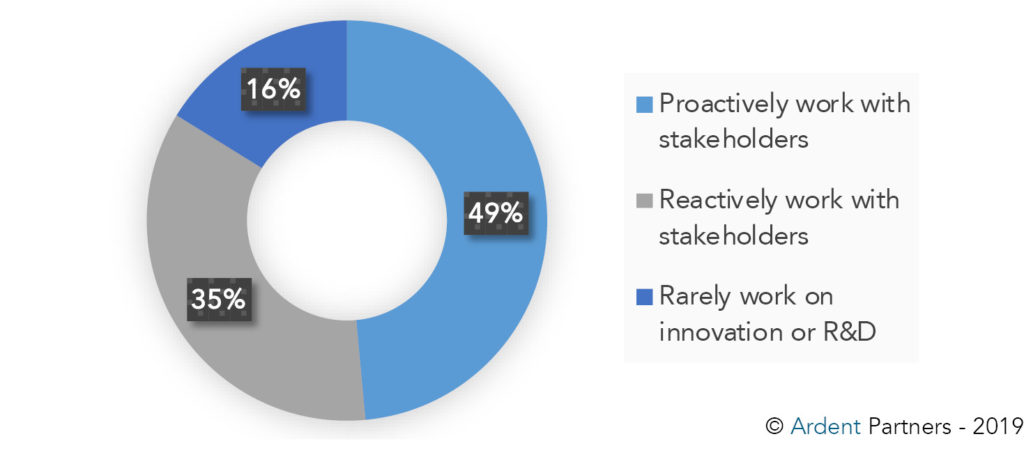Publisher’s Note: Today’s article includes a large excerpt Ardent’s annual “State of Procurement” research report, CPO Rising 2019: Value Expansion. This report is based upon the responses from more than 300 CPOs and is the culmination of a year’s worth of research, conversations, and insights. We consider it a “must-read’ for procurement professionals. Today’s article contains a large excerpt from this report and it is available now by clicking here.
House of Procurement (Part 1) – When Innovation Knocks, Answer the Door
It is Ardent Partners’ view that many of an enterprise’s larger, long-term opportunities will depend on how well its procurement department identifies and drives innovation within the enterprise and leverages it from across the supply chain. As you can see from the chart below, in 2019, essentially half (49%) of all procurement teams report that they proactively work with their business stakeholders to understand innovation and their R&D needs; and that they also work to bring relevant suppliers to the table to discuss innovative ideas. This is both good and necessary because procurement neither operates in a vacuum, nor has it cornered the market on innovation. Internal stakeholders and progressive suppliers can have innovative ideas to contribute to the larger discussion on driving more value through procurement and throughout the enterprise. Chief Procurement Officers not only have to reach across the hall to spark innovation, they also have to open their door when innovation knocks.
Figure: Procurement’s Approach to Innovation

But, in 2019, procurement’s innovation glass is only half full – as the above illustrates – 35% of all procurement teams respond to changing business needs reactively and only occasionally tap relevant stakeholders for their advice and input. And, 16% of all procurement teams rarely, if ever, work on innovation and R&D initiatives with the rest of the enterprise or their supplier base – a missed opportunity to innovate and improve performance.
Innovation does not simply “happen” – it is not a “light- bulb idea.” Rather, it takes continuous effort over an extended period to identify, develop, manage, and deliver innovation. For those 51% of procurement teams that are not proactive in their pursuit of innovation, here are two recommendations to get started.
- Make procurement a collaboration and innovation hub: Collaboration is not simply the reason to call a meeting; it can become an operating principle. While innovative ideas need time to incubate, they also benefit from a collision of perspectives and expertise. With an ability to support and impact the lines of business and most business functions, procurement is uniquely positioned to bring interdisciplinary groups together on collaborative projects. And from that collaboration, procurement will emerge a more innovative business unit.
- Proactively work with the business and supply base to define innovation and R&D requirements: Procurement teams of all shapes, sizes, and maturity classes need to work proactively with their internal stakeholders and their supply base to understand innovation from each perspective; and then use that knowledge to inform how procurement can expand the most value for its constituents. Procurement teams should not wait for business partners and suppliers to approach them; CPOs and procurement teams should make the first move.
RELATED ARTICLES
Beeline Conference 2019 Recap: The Age of Talent-Driven Digital Transformation
Monday First Thing: Art Meets Innovation at IvaluaNOW 2019
From Industry 4.0 to Procurement 4.0: Turning Innovative Ideas into Innovation
Ardent’s Monthly Webinar Series Continues: This Month – The State of ePayables May 25th 2 pm
Tagged in: Ardent Partners Research, Chief Procurement Officer, Collaboration, CPO, Innovation, Monday First Thing, Supplier Relationship Management, Suppliers









